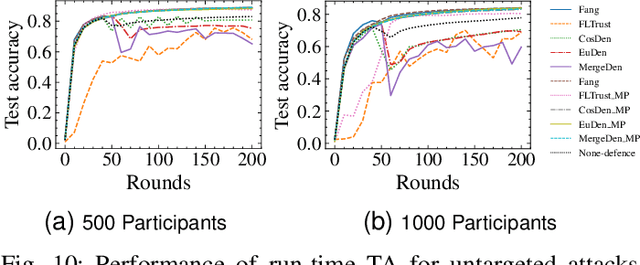Zirui Gong
Not All Edges are Equally Robust: Evaluating the Robustness of Ranking-Based Federated Learning
Mar 12, 2025Abstract:Federated Ranking Learning (FRL) is a state-of-the-art FL framework that stands out for its communication efficiency and resilience to poisoning attacks. It diverges from the traditional FL framework in two ways: 1) it leverages discrete rankings instead of gradient updates, significantly reducing communication costs and limiting the potential space for malicious updates, and 2) it uses majority voting on the server side to establish the global ranking, ensuring that individual updates have minimal influence since each client contributes only a single vote. These features enhance the system's scalability and position FRL as a promising paradigm for FL training. However, our analysis reveals that FRL is not inherently robust, as certain edges are particularly vulnerable to poisoning attacks. Through a theoretical investigation, we prove the existence of these vulnerable edges and establish a lower bound and an upper bound for identifying them in each layer. Based on this finding, we introduce a novel local model poisoning attack against FRL, namely the Vulnerable Edge Manipulation (VEM) attack. The VEM attack focuses on identifying and perturbing the most vulnerable edges in each layer and leveraging an optimization-based approach to maximize the attack's impact. Through extensive experiments on benchmark datasets, we demonstrate that our attack achieves an overall 53.23% attack impact and is 3.7x more impactful than existing methods. Our findings highlight significant vulnerabilities in ranking-based FL systems and underline the urgency for the development of new robust FL frameworks.
AGRAMPLIFIER: Defending Federated Learning Against Poisoning Attacks Through Local Update Amplification
Nov 23, 2023



Abstract:The collaborative nature of federated learning (FL) poses a major threat in the form of manipulation of local training data and local updates, known as the Byzantine poisoning attack. To address this issue, many Byzantine-robust aggregation rules (AGRs) have been proposed to filter out or moderate suspicious local updates uploaded by Byzantine participants. This paper introduces a novel approach called AGRAMPLIFIER, aiming to simultaneously improve the robustness, fidelity, and efficiency of the existing AGRs. The core idea of AGRAMPLIFIER is to amplify the "morality" of local updates by identifying the most repressive features of each gradient update, which provides a clearer distinction between malicious and benign updates, consequently improving the detection effect. To achieve this objective, two approaches, namely AGRMP and AGRXAI, are proposed. AGRMP organizes local updates into patches and extracts the largest value from each patch, while AGRXAI leverages explainable AI methods to extract the gradient of the most activated features. By equipping AGRAMPLIFIER with the existing Byzantine-robust mechanisms, we successfully enhance the model's robustness, maintaining its fidelity and improving overall efficiency. AGRAMPLIFIER is universally compatible with the existing Byzantine-robust mechanisms. The paper demonstrates its effectiveness by integrating it with all mainstream AGR mechanisms. Extensive evaluations conducted on seven datasets from diverse domains against seven representative poisoning attacks consistently show enhancements in robustness, fidelity, and efficiency, with average gains of 40.08%, 39.18%, and 10.68%, respectively.
Yield Evaluation of Citrus Fruits based on the YoloV5 compressed by Knowledge Distillation
Nov 16, 2022Abstract:In the field of planting fruit trees, pre-harvest estimation of fruit yield is important for fruit storage and price evaluation. However, considering the cost, the yield of each tree cannot be assessed by directly picking the immature fruit. Therefore, the problem is a very difficult task. In this paper, a fruit counting and yield assessment method based on computer vision is proposed for citrus fruit trees as an example. Firstly, images of single fruit trees from different angles are acquired and the number of fruits is detected using a deep Convolutional Neural Network model YOLOv5, and the model is compressed using a knowledge distillation method. Then, a linear regression method is used to model yield-related features and evaluate yield. Experiments show that the proposed method can accurately count fruits and approximate the yield.
 Add to Chrome
Add to Chrome Add to Firefox
Add to Firefox Add to Edge
Add to Edge